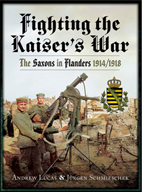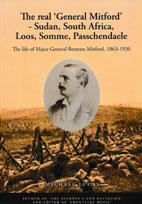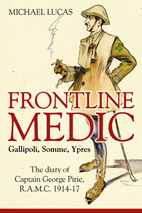Since the publication of Fighting the Kaiser's War we have inevitably discovered some errors. We were also frequently obliged to write more concisely than we would have liked due to pressure of space.
NB: This list of addenda and corrigenda applies primarily to the original 2015 hardback edition. Many of the corrections and some of the additional information has been incorporated into the 2022 paperback edition (so far as the available space permitted). The list here will be updated irregularly as and when we feel the need to correct or expand on points in the book.
pp.3, 54, 186, 188 & 249 The surname of Hauptmann der Reserve Ernst Krippendorff has been misspelled (with one 'f') throughout the text, an error we picked up from secondary sources. 'Krippendorff' is confirmed as the right spelling from this unfortunate gentleman's gravestone and funeral notice. We now also know that his brother Oberleutnant der Landwehr a.D. Dr. jur. Arthur Heinrich Krippendorff was likewise both a lawyer and a Royal Saxon reserve officer. Being substantially older (born 1859), Arthur had retired from even part-time military service before the war and was given a post on the home front, serving with Landsturm-Ersatz-Bataillon XII.14 and as adjutant to Kommandantur Groß-Poritsch. Sadly he did not survive the war either, dying of illness in Reserve-Lazarett I Dresden on 12th January 1916 at the age of 56.
p.16 (photo caption) I have since discovered assessments of my Great-Grandfather Arno Bierast's suitability for promotion among the personnel paperwork of Feldartillerie-Regiment 48 (at the Saxon archives in Dresden). As a Kriegsfreiwilliger (war volunteer) from an educated background who had already been promoted to Gefreiter (lance-corporal) before he joined 3. Battr. / FAR 48 in the field on 12th October 1914, Arno appears early in 1915 in a list of volunteers considered suitable for later promotion to Unteroffizier (corporal). However when he appears again on 10th June in a list of volunteers under assessment as potential officer or NCO candidates, he is now judged 'not suitable for promotion'. No further mention of him could be identified in the time I had with the documents. My previous belief that he reached higher rank was based on misinterpretation of a photo of him from summer 1916 where he appears to wear the larger NCO's rank button on his collar.
p.21 (photo caption) The gentleman to the Crown Prince's right among the assembled officers of IR 104 ca. May 1918 is not in fact his father (as I believed for many years, falsely associating the photo with H.M. the King's visit to the regiment on 7th May). It is in fact Major Karl Facius (commander of II Batl. / IR 104), who bore a striking resemblance to H.M. A captioned version of the picture (below) appears in an appendix to the third volume of the regimental history of IR 104, one of the most lengthy and detailed works of its kind. Facius gets several mentions in For King and Kaiser within the chapters on Frelinghien and Ploegsteert Wood.
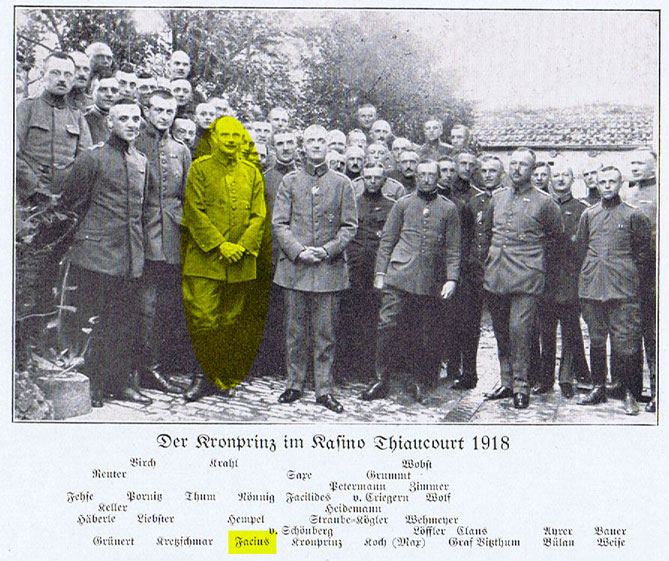
p.27 HRH Albrecht of Württemberg was a duke (Herzog) rather than an archduke (Erzherzog).
p.28 Leutnant Hans-Wolf von Schmieden was born in Dresden on 12th October 1894 and educated at the König-Albert-Gymnasium in Leipzig before beginning an active officer's career with IR 107. He was commissioned as a Leutnant on 24th February 1914, and transferred from the I. Ersatz-Bataillon / IR 107 to RIR 244 during the formation of that regiment. He was killed in action with 11./244 during the assault on Polygon Wood on 24th October 1914. As noted in the book, his father was Generalmajor z.D. August von Schmieden (commander of the newly designated 105. Reserve-Infanterie-Brigade from late November).
p.42 (photo caption right) We now know that the Offizierskasino of IR 139 at this time (which featured this charming wall painting) was in the Château Agache at Pérenchies. Sadly this building did not survive the war.
p.46 The account of the formation of the specialist gas engineers given here is rather confused. In February 1915 the original experimental formation known as Desinfectionstruppe Peterson arrived in Flanders, where it was gradually expanded with groups of volunteers drawn from existing units of 4. Armee - first to a 'Regiment Peterson' and then to two numbered regiments. Multiple Württemberg sources refer to an Infanterie-Pionier-Kompagnie 5 'Schmelzer', formed at Gheluwe on 8th April 1915 from Infanterie-Pioniere of RIR 246, 247 and 248; these sources also allege the existence of two further companies formed from "den übrigen Infanterie-Regimentern des Korpsverbands", which would seem to indicate that said companies were Saxon. According to the same sources, Pionier-Regiment 35 was officially formed on 10th May, with six companies divided into two battalions (in addition to a depot company, weather station and telephone detachment); the Württemberg company became 2. / PR 35 and its two supposed sister companies 1. and 3. / PR 35. Prussian Verlustlisten and Feldpost do indeed show the presence of some identifiably Saxon personnel in 1. and 3. / PR 35, but they certainly do not appear to have been in the majority.
Pionier-Regiment 36 is believed to have come into existence more or less simultaneously; the personal account of Ltn. d. R. Gerhard (a transferee from RIR 201 to the gas troops) asserts that both regiments came into existence together around the end of April, by dividing up the twelve companies to which Oberst Peterson's force had grown by that time. Gerhard implies that Pionier-Regiment 36 (to which he henceforth belonged) actually received the majority of the most experienced personnel, despite being numbered as 'junior'. Gerhard's regiment was swiftly despatched to the Eastern Front (on April 26th according to his account), leaving Pionier-Regiment 35 to continue operations in Flanders. The more 'amateur' composition of PR 35 and the inferior state of its equipment at this early stage appear to have contributed to the disaster suffered by 53. Reserve-Division on 24th May (pp.49 and 51).
pp.48-52 The account of the Second Battle of Ypres here suffered from the problem of trying to cover too much in too little space, hence our returning to the theme at greater length later. The account in For King and Kaiser reflects the current state of our knowledge.
p.48 After "...and take Hill 32 (see map p. 51)", the following two sentences should be replaced with the following: At 5am chlorine was discharged against the Canadians from the trenches of 2. Reserve-Ersatz-Brigade. A third of 8th Btn. and a quarter of 15th Btn. CEF were affected, and about 6 am wounded and gassed men could be seen falling back.
The sentence beginning "On the 26th" should be replaced with the following: Early on the 26th the Sturmbrigade reached s'Gravenstafel and the crossroads on the Langemarck-Zonnebeke road.
The first sentence of the new paragraph on p.48 should be replaced with the following: On 3 May the tip of the salient at Berlin Wood fell to III./241 and I./243 supported by Regiment von Heygendorff, but only after hours of repeated heavy bombardment and severe losses. By evening RIR 241 was 50m from Hill 38 (Abraham Heights), with RIR 243 further back on the left.
p.49 "...with two regiments per division in line" - this is incorrect. The corps advanced with two regiments of 53.RD and three of 54.RD abreast.
There were multiple British counterattacks after RIR 242 overran Wilde Wood, none of which succeeded in dislodging the Saxons.
p.55 Major (later Oberstleutnant) Alfred von Heygendorff of RIR 245 is a featured diarist in For King and Kaiser and the subject of an additional article on this website.
p.60 The order of battle here gives a slightly distorted picture of the forces directly available to the corps in June 1915, since IR 133 and 134 were both being held in army reserve (hence the provision of LIR 77 and LIR 78 to hold their usual sectors in their absence). This will be noted in the version of this order of battle which appears in the paperback edition.
p.62 (map) and p.66 (lower photo caption) To be more precise, following the withdrawal of IR 107 the new inter-regimental boundary between IR 179 (south) and IR 139 (north) was at the Rue du Bois.
p.62 (text) The last sentence of the first paragraph should be replaced with the following: Frelinghien was already another, as was the 'Birdcage' at Ploegsteert Wood from late May (see p.114-117). Ultimately the whole front became dotted with mine shafts.
p.73 Although attempts to rectify the provisional armament of the 58. Inf. Div. with the old Gewehr 88 began as soon as late May, it seems that IR 107 drew the short straw and was the last to be rearmed... on 15th December 1915! As for the Württembergers, RIR 120 seems to have kept the Gewehr 98 throughout (which may have contributed to its apparently greater effectiveness). These minor errors were unfortunately discovered too late to be corrected in the paperback edition.
p.89 Leutnant der Reserve (later Oberleutnant) Alfred or Alexander Pache of IR 182 is a featured diarist in For King and Kaiser and the subject of an additional article on this website.
p.101 (upper photo caption) The depicted celebration of the Kaiser's birthday by RIR 241 on 27th January 1916 actually took place in Ingelmunster rather than in Iseg(h)em.
p.103 (lower photo caption) This is indeed a royal visit to the XXVII.RK HQ at Château Mariënstede in Dadizele, but by H.M. King Wilhelm II of Württemberg rather than the King of Saxony. The venue for visits to the corps by either monarch was certainly the same and the protocol similar, while the troops to be paraded were typically drawn exclusively from the relevant kingdom's contingent - a prime example of the separate and parallel social and ceremonial lives of the Saxons and Württembergers within XXVII.RK.
p.112 The last sentence of the first paragraph should be replaced with the following: IR 179 relieved LIR 77 at Frelinghien, where they soon faced flooding when the Lys burst its banks. See For King and Kaiser Chapter 2 for much, much more on the breweries at Frelinghien and their garrisons.
p.115 (lower photo caption) Each division of XIX.AK formed existing independent Minenwerfer units into a divisional Minenwerfer-Kompagnie with two heavy, four medium and six light weapons in December 1915.
p.134 The text from "despite frequent battalion reliefs" onwards should be replaced with the following: By the end of May the division was so exhausted that it was transferred to Gruppe Aubers for training. Meanwhile the bombardment of the salient from three sides by the massed artillery of British 2nd Army intensified. At Wytschaete, 2.ID was so badly mauled that 24.ID had to be recalled on 6 June to relieve it. Fortunately for the Saxon division, its transportation back from Lille was still underway when all hell broke loose.
p.135 When the 24. Infanterie-Division was put back into the line on the night of 13th-14th June 1917, the regimental subsectors were as follows from left to right: IR 139, IR 179, IR 133.
p.147 Although the location of this photo is identified on the reverse as such, a local expert informs us that this is not in fact the (known and documented) windmill in Maldegem. The exact location is currently unidentified.
p.150 (upper photo caption) This location was kindly identified for us as the seaside resort of Knokke by Alain Van Geeteruyen, an expert on Marinekorps Flandern who grew up there.
p.157 The final sentence of the first paragraph is confusing, and should be replaced with the following: On 25 March IR 177 and 103 shifted southward, now respectively in the centre and on the left at Wez-Macquart.
p.160 The first sentence was accidentally duplicated in the text!
The first paragraph should be replaced with the following: The line facing Poelkapelle was held from left by IR 107, IR 106 and RIR 103, each with three companies forward and three in support. Initially neither the outpost line nor the Hauptwiderstandslinie (Schaap-Balie–Wallemolen road) was wired, and men went astray before a fence was put up. Luckily the British did not attack before the thaw on 13 January and onset of rain made much of the area impassable. While shelling and air raids were sometimes severe, Saxon patrols went unchallenged. On 24 January a party from I. / RIR 103 seized two prisoners. Relieved by 204.ID on 2-4 February, 58.ID was due for four weeks of training for mobile warfare. It returned early on the night of the 25th-26th, with Prince Ernst Heinrich commanding 9. / FAR 115. Until late March the enemy was jumpy and shelling heavier. Westrozebeke was abandoned after 5. / IR 107 lost fifteen dead to a direct hit on the 9th. Saxon raids repeatedly failed, twice due to artillery drop-shorts. Gruppe Staden was reduced from three to two divisions on the night of 23–24 March, and IR 107 moved to the new right flank at Houthulst Forest with IR 106 centre and RIR 103 left.
p.164 Our understanding of the various Saxon provisional formations assigned in 1914 to the Prussian border fortresses in the east has greatly improved since the writing of the first edition.
The first paragraph should be replaced with the following: Formed in September 1914 as Landwehr-Brigade-Ersatz-Bataillon 48, this provisional battalion was sent to Poland on 3rd October and fought with Korps Breslau in the Battle of Łódź that November. On 20 February 1915 it became the III Bataillon of the mixed Landwehr-Ersatz-Infanterie-Regiment 9 within 'Division Menges' (88.ID), and saw heavy fighting that year. LEIR 9 was redesignated IR 354 on 2nd August. Together with IR 182, it was transferred to 216.ID in September 1916 and sent to Transylvania. By 1918 it was apparently the sole Saxon element in its division but still retained its distinct identity. Its officers also served at times as regimental adjutant and commander of II. / IR354..
For more on this subject, please see my article 'Home Service' Units far from Home: the Saxon Garrison of Breslau (1914-1917) on Facebook.
p.171 As noted here, photos of Saxon signals troops almost always show the use of the old 'T7' shoulderstraps taken from the peacetime Telegraphen-Bataillon 7. However we have also seen a single example taken in late 1917 of 'T19' - representing the new wartime depot formation for the XIX.AK district, Nachrichten-Ersatz-Abteilung 19. Presumably the new shoulderstraps would have also been intended to replace 'T7' within all the field formations served by Nachr. Ers. Abt. 19. We do not yet have any photographic evidence for the issue and wear of 'T12' shoulderstraps (for Nachr. Ers. Abt. 12, the equivalent depot formation for the XII.AK district).
p.172 Thanks in part to additional archival information and in large part to the kind assistance of Alain Van Geeteruyen, we now know a great deal more about the independent Mörser-Batterie 201 and 202.
The potted history of these batteries in the first paragraph of the main text should be replaced with the following: In early 1915 the depot of FußaR 12 at Metz formed two batteries with the obsolete 21cm Mörser of 1899, which lacked a recoil cylinder. By May, Mörser-Batterie 202 was with the Marinekorps, firing from the Tempelhofstellung south of Slijpe (site of a ruined Templar preceptory) toward Nieuwport and Ramskapelle. Mörser-Batterie 201 was initially allocated to XXVII.RK, but by January 1916 was south of the Menin Road with XV.AK (later XIII.AK). The two batteries were seemingly merged to form Fußa.Batl.72 in September 1916 and remained in Flanders.
For more on this subject, please see my article Old, slow and devastating - Mörser-Batterie 201 and 202 in Flanders, 1915-1916 on Facebook.
p.172 Alas, this correction was too late for the paperback edition! Some of the details of the armament of the Saxon Fußartillerie formations employed in Flanders in April-May 1918 are incorrect, actually reflecting the armament of the same units that October. Thanks to Rainer Werner I now have a schema for the artillery of Gruppe Flandern and Gruppe Wytschaete plus additional available 4. Armee assets, as of 10th April. It includes the following:
Regts. Stab / FussaR 19 (under Major Max Schmidt; one of two regimental staffs attached to XVIII. RK (Gruppe Wytschaete))
IV. / FussaR 12 (staff, two 21cm Ms 10 and one 21cm lange Ms 16 batteries; attached to XVIII. RK (Gruppe Wytschaete); 3. Battr. (21cm Ms 10) 'immobile' i.e. without horses)
I. / RFussaR 12 (staff & three 21cm Ms 10 batteries; 4. Armee asset supporting Gruppe Flandern)
IV. / FussaR 19 (staff, 4. Battr. with 10cm K, 11. Battr. with 15cm sFH 13, 12. Battr. with 15cm lange sFH 13; attached to XVIII. RK (Gruppe Wytschaete); 11. Battr. 'immobile' i.e. without horses)
Fussa. Batl. 72 (staff, one 21cm lange Ms 16 and one 15cm K 16 Krupp battery; 4. Armee asset supporting Gruppe Flandern; location at this time of its other battery is unknown)
There is no mention in the schema of III. / FussaR 12, II / FussaR 19, Fussa. Batl. 105, all of which served at some point during the April-May 1918 fighting in Flanders according to other sources.
p.173 (upper photo caption) Since the appearance of the paperback edition another copy of this photo has come to light, on which the unit is definitively identified as 3. Battr. / Res. Fußa. Batl. 12 (not yet a regiment at this point). The only reference we have found to the battalion's service in Flanders in 1915 is in the MStHO citation for its commander, Major Johannes Schulze. While concentrating on Schulze's leadership on the Arras front that June, he is also praised for calmly observing at the scissors periscope "under the heaviest fire" while "before Ypres at the beginning of August". We have yet to discover whether the entire battalion was committed, where exactly it was employed or why it was felt necessary to send this valuable asset to Flanders at the time.
p.174 (lower photo caption) Thanks to Francis Devlamynck, we now know a great deal more about this obscure unit. The Parkkompagnie of I. Batl. / FußaR 12 served Gruppe Diksmuide from 7 August, then Gruppe Staden from 1 December 1917. This photo is probably from January 1918 when the company was at Munitions-Depot Lichtervelde, since it was redesignated and numbered as Artillerie-Parkkompagnie 60 on 5 February 1918.
p.175 (upper photo caption) This location has been identified by Francis Devlamynck as Kortewilde east of Diksmuide (there are multiple places with this name in Flanders).
p.175 It recently (too recently alas for the paperback edition) came to our attention that elements of EFAR 45 were briefly sent to the Western Front in summer 1918, while their parent 219.ID (see pp.144-145) was on occupation duty in the Baltic - and consequently in limited need of artillery. Remarkably, I. / EFAR 45 actually returned to Flanders, serving with 58.ID in the Kemmel sector (see p.161) from 11 July to 11 August 1918. The Abteilung had been intended to reinforce the divisional artillery for the abortive Hagen offensive, and rejoined 219.ID in the east after its cancellation.
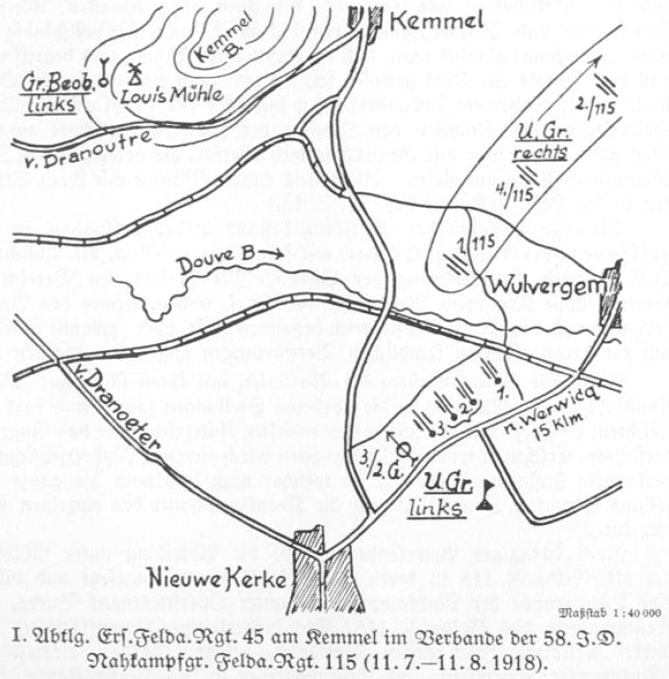
p.176 (photo caption) An album belonging to Uffz. Karl Keller of 3.Reserve-Kompanie / Pionier-Bataillon 22 recently came to light, revealing that this company was attached specifically to 46. Reserve-Division / XXIII. Reserve-Korps in its sector north of Ypres at least as early as February 1915.
p.176 The gas unit mentioned here should arguably be referred to as Pionier-Regiment 35; see discussion of gas engineers under p.46 above.
p.178-180 This entire section on the Saxon Landsturm has been rewritten as follows for the paperback edition, based on the research embodied in the series of articles on the subject which I produced during lockdown.
All male Germans aged 17–45 and not otherwise serving were liable for the Landsturm. While trained reservists over 38 formed a few cavalry, artillery and pionier units at mobilisation, they were far outnumbered by Landsturm-Infanterie-Bataillonen. Though intended for duties at home and in the rear, some of these served in the trenches on quieter fronts. They were often obliged to trade their fitter men for convalescents no longer fit for the front (see pp. 182–185). For instance Ldst. Inf. Batl. XII.20 was formed in November 1916 from 1,200 downgraded infantrymen of 53.RD. At least thirteen Saxon battalions saw mostly rear-area service in Flanders.
1. Ldst. Inf. Batl. Leipzig XIX.1 was briefly with Et. Insp. 4 in September 1914, and may have returned in 1918. 2. Ldst. Inf. Batl. Leipzig XIX.2 was in Wallonia as of September 1914, moved to Antwerp at some point after May 1915 and stayed in Belgium for the duration. 2. Ldst. Inf. Batl. Dresden XII.2 was around Brussels from 22 September 1914 until sent to the Eastern Front in July 1916.
Ldst. Inf. Batl. Wurzen XIX.9 served around Kortrijk from November 1914 mainly in railway defence, shooting down the French aviator Roland Garros at Lendelede in April 1915 (see p. 211). 3. Ldst. Inf. Batl. Chemnitz XIX.12 was west of Gent from December 1914. From early September 1915 both battalions guarded the Dutch border, respectively north of Gent and near Antwerp. American journalist Frederick Palmer met one of these men on the Roosendaal–Antwerp road in late December 1914:
(the quote from Palmer's My Year of the War is unchanged)
Both battalions were relieved in mid-September 1916 to be trained for trench warfare in the Argonne. At the same time 2. Ldst. Inf. Batl. Chemnitz XIX.11 also left Flanders after two years mostly around Gent and Leuven.
Ldst. Inf. Batl. Zwickau XIX.18 guarded the Franco-Belgian border from late October 1914 to September 1916, with posts at Willems, Cahos, Mouscron and Templeuve. Its HQ was likely at Tournai, where Genmaj. Kaden (cf. pp. 204–211) met its commander Oberstltn. a.D. Alfred Schuster (an old friend) on 15 April 1915.
12. Ldst. Inf. Batl. Leipzig XIX.31 was with 4. Armee from August 1917 onwards, as were 1. Ldst. Inf. Batl. Dresden XII.1 from April 1918, 8. Ldst. Inf. Batl. Leipzig XIX.25 from June and at least part of Ldst. Inf. Batl. XII.22 from September. From late March 1918, Ldst. Inf. Batl. Pirna XII.5 was also in Flanders, based around Antwerp until at least July. The detached 3. Komp. / 2. Ldst. Ers. Batl. Chemnitz XIX.13 served the Generalgouvernement in 1918, apparently supplying guards for the ex-Belgian military prison in Vilvoorde.
The Landsturm also raised dedicated guard units for P.O.W. and civilian labour such as Bewachungs-Kompanie 69 (at La Bassée in April 1917). At least one Saxon Armierungs-Bataillon of Landsturm recruits judged fit for work but not to bear arms also provided labour in Flanders in 1918.
p.180 (lower photo caption) The unit here has been firmly identified as Reserve-Fernsprech-Abteilung 27 of XXVII. Reservekorps, so not an 'independent unit' at all. In the paperback edition, this photo and the one at top left (the likewise only tangentially relevant XXVII. Reservekorps anti-aircraft gun) have therefore been replaced with a previously unseen photo of Bewachungs-Kompanie 69.
p.182 It is worth noting (as we have done in the paperback edition) that the Charité was renowned for the world-class plastic surgery it offered to mutilated soldiers. Given the timing of Erich Kühn's death, I am now inclined to believe that he was most likely a victim of the Spanish Flu.
p.184 (map caption) RIR 244 attacked from the '22.10.14' line early on the 24th. The survivors fell back to the ‘24.10.14’ line while RIR 246 occupied Reutel.
pp.186-189 As mentioned above the surname of Hauptmann der Reserve Ernst Krippendorff has been misspelled (with one 'f') throughout the text, an error we picked up from secondary sources.
p.188 (upper photo caption) Given the date and the fact that each officer is visibly wearing the Riechpäckchen, I believe that the goggles are likely for gas protection.
p.189 (lower photo caption) The military policemen here are believed to belong to the Feldgendarmerietrupp des XXVII.RK, and are wearing dark green Saxon civil police tunics and gorgets. A beautiful photo of one of these gentlemen appears on p.120 of For King and Kaiser.
p.190 A post-war photo has since come to light of Curt Penther as Branddirektor (fire chief) of Löbau, indicating a change of career after WW1.
p.197 Curt Penther's brother Georg (whose full name was either Georg Hermann or Hermann Georg Penther) was serving with Prussian RIR 19 of 9. Reserve-Division when he was killed in action on the Verdun front.
p.200 (photo caption) Waterdamhoek was the rear-area home of RIR 245 from November 1914 to July 1915 (see For King and Kaiser pp.146-148).
p.204 Re. Generalmajor Kaden's early career: an Avantageur was an officer candidate under the older system which still prevailed in 1879. It is also important to note that Kaden was trained as a staff officer, attended the Preußische Kriegsakademie in Berlin and subsequently held posts both with Saxon infantry regiments and on the Saxon Generalstab before reaching his final peacetime position as commander of 48. Infanterie-Brigade.
Please see also my article Roland Garros meets his match - Lendelede railway station, April 1915 which draws on Generalmajor Kaden's diary.
p.206 The entry header "Thursday 5 November 1915" should obviously read "...1914".
p.210 (photo caption) The depicted gun is one of four 28cm pieces of Batterie Hindenburg, part of Hafenschutzgruppe Ostende-Ost. Going by his description, Kaden must have visited Nahkampfgruppe Mariakerke further to the west.
p.223 Re. the position of IR 179 in October 1917, the text "on the Saxon right, immediately to the south of the Menin Road" should be corrected to on the Saxon right astride the Menin Road (see For King and Kaiser pp.195-202).
p.235 The last sentence of the first paragraph should be replaced by the following, which adds more detail: Later it was joined by (Divisions-)Funker-Abteilung 135 with radios. That autumn both units came under command of (Divisions-)Nachrichten-Kommandeur 58, with the establishment of the Nachrichtentruppen (signals service).
Gefreiter Wittig's assignment to an Unteroffizier's post (Truppführer) and his unit's appointment of a mere Sergeant as Wachtmeister-Diensttuer (see p.239) both seem to suggest that there was a serious shortage of trained Nachrichtentruppen NCOs at the time.
p.246 (Chapter 6 Note 9) Genltn. Traugott Freiherr Leuckart von Weissdorf was commander of 23. Reserve-Division from February 1917 until March 1918.
p.246 (Chapter 9 Penther Note 1) The Feldrekrutendepot des XXVII.RK is known to have been operational in Oudenaarde at least as early as June 1915. No order for its establishment has yet come to light.
p.246 (Chapter 9 Penther Note 3) Genmaj. Gustav von der Decken was also awarded the Komturkreuz II. Klasse of the MStHO on 8 April 1917 as commander of 32. Inf. Div.
p.247 (Chapter 9 Conrad Note 3) A Landwehr-Bezirkskommando (Landwehr district command) was an office responsible for the administration and wartime mobilisation of the Landwehr and Landsturm within its local area; please see my article Peacetime garrisons of the Royal Saxon Army for Bezirkskommandos in Saxony.
p.248 (Chapter 9 Kaden Note 23) We cannot substantiate Kaden's story, but Gen. d. Inf. d'Elsa's sons had indeed been killed in action in 1914, Hptm. Walter d'Elsa with GR 101 at Rosée on 24 August and Ltn. Karl d'Elsa with LGR 100 at Bertoncourt on 30 August (so both serving with units of their father's corps). The Saxon Verlustliste of 21st September 1914 lists both Gen. der Inf. d'Elsa and Oberst von Eulitz as lightly wounded, in the right upper arm and right thigh respectively. Listed alongside them is a Soldat Michael Eckstein, also assigned to GenKdo XII.AK (so presumably a batman, groom or clerk) and severely wounded in the right thigh. No further explanation of the events which led to these highly unusual casualties at corps HQ has yet come to light.
p.248 (Chapter 9 Kaden Note 27) For further discussion of the Garros incident, please see my article Roland Garros meets his match - Lendelede railway station, April 1915.
p.248 (Chapter 9 Brückner Note 3) Each German soldier was in fact issued with two field dressings.
p.248 (Chapter 9 Wittig Note 6) The smallest field formation with an official 'padre' was the division, initially with one etatsmässige Divisionspfarrer (establishment divisional pastor) of the majority denomination - which was always Protestant in Saxony. In wartime each division had at least one Roman Catholic and one Protestant Divisionspfarrer, often reinforced by additional volunteer Hilfspfarrer.
This was clarified for us by Jürgen's discovery of the diary of Roman Catholic Divisionspfarrer Ziesch of 40. Inf. Div., who explicitly describes himself as etatsmässiger katholischer Divisionpfarrer in June 1917. His description of the mobilisation in summer 1914 indicates that he was already equipped as an 'establishment' pastor at that point (with a wagon for ecclestiastical equipment, a driver, a riding horse and a groom), despite the modest size of his flock. While formations recruited heavily from the Oberlausitz (such as 32. Inf. Div.) included a significant minority of Roman Catholic Sorbs, their co-religionists in the 40. Inf. Div. were largely limited to Polish economic migrants who had settled in the industrial areas of Western Saxony prior to the war.
Andrew Lucas, last updated 10th December 2024

